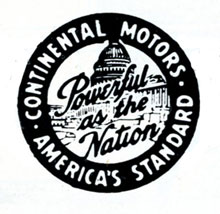We have a winnah! First to report in with the correct answer to last week’s “list quiz” was Jonathan Baker from Australia, who was also the only one with the correct answer. With no equivocation he said the common denominator in the ten cars was their Continental engines. Actually, it’s more accurate to say “Continental-derived,” because some of the cars didn’t actually have their engines built by the Continental Engine Company.
A blatant hint in the list was the Continental Flyer, a car actually built by the Continental Engine Company. We told you about that back in February 2005. Flint and Jordan are well known users of bought-in engines; the ’27 Jordans used the Continental 8-S, the Flint E-55 a 6-E (there’s no rhyme nor reason to Continental numbering – both the 8-S and 6-E are sixes).
DuPont was a luxury car maker, but did not manufacture engines. The eight-cylinder DuPonts, Model G from 1929 on, used an L-head Continental 12-K, but added their own cylinder head cover that made it look like an overhead valve unit.
Hudson is known for outsourcing very few parts, but Hudson didn’t actually build engines until the Super Six of 1916. Until then, all Hudson engines were bought in from Continental. Hudson historian Don Butler says that Hudson designed the Six-54 engine for Continental to build. Marshall Naul, however, identifies the Six-54’s engine as a Continental 6-C, also used by Colby, Howard and Pathfinder. They could both be right. Automotive history is like that.
When the Graham brothers took over the Paige-Detroit Motor Car Company, they inherited the Paige product line, which used a mix of Continental, Lycoming and their own in-house powerplants. The Grahams took over manufacture of the sixes, but used Continental eights for a few years. The economy Crusader model introduced in 1936, however, used a bought-in six-cylinder Continental C-600.
Kaiser, too, manufactured engines, but rather than design their own took a tried-and-true Continental six and made changes to the valves and combustion chambers. They even leased a Continental plant to build it. After purchasing Willys in 1953, Kaiser 226 cid sixes began to appear in Willys trucks and station wagons. Ironically, Willys had supplied fours and smaller sixes to Kaiser since 1951 for the Henry J.
Federal Motor Truck Company also bought engines from outside, Hercules for their lighter trucks, and Continental for the larger ones, from Model 45 up.
So what about the Ferguson tractor? Well, when Harry Ferguson and Henry Ford were still on good terms, their Ford Model 9N (sometimes called “Ford Ferguson,” properly “Ford with Ferguson System” hydraulics) used Ford engines. When the handshake partnership broke up and Ferguson turned to the courts, the new Ferguson tractor was powered by a Continental Z-120 engine, a 120-cubic-inch overhead valve four. These were known as TO20 models (Tractor Overseas), while in England a TE20 (Tractor English) used an engine of the same size from the Standard Vanguard. We got to know this engine in Triumph TR sports cars. British Fergusons were also early users of diesel power.
For further reading about Continental engines, seek out Special Interest Autos #38, the January-February 1977 issue. In it, Marshall Naul gives chapter and verse on Continental’s US-built passenger car engines. Today Teledyne Continental Motors builds piston and turbine engines for light aircraft.

